LG C4 is a television that will likely have no competition in its price range for many users. Thanks to the wide options for purchase, it will appeal to those looking for a TV strictly for movies and series, as well as for gaming. The advanced WebOS system and a remote that works like a mouse will certainly make everyday use much easier and ensure that we will likely stick with this brand for a much longer time. The OLED panel implemented by the manufacturer, resulting from over 10 years of history, shows that it has not yet said its last word. Brightness results in HDR material are very solid and can display an incredibly dynamic and deep image. Here, it’s worth mentioning the excellently implemented dynamic tone mapping feature, which makes HDR10 images look almost as good as Dolby Vision. And if we’re talking about fidelity to artistic vision, we can't forget about how calibratable LG TVs are, allowing for a great deal of freedom for the calibrator and classic calibration for home users, as well as 3D LUT for professionals. However, if we are looking for a gaming TV, then the LG C4, like most of the manufacturer’s OLED TVs, will be the ideal choice. With the implementation of HDMI 2.1 ports and the full use of their potential, we can enjoy extremely smooth gameplay with all the benefits, such as VRR, ALLM, FreeSync, or G-Sync. Of course, the panel, which has a maximum refresh rate of 144 Hz and an advanced smoothing technology, will also allow for very smooth and sharp images during broadcasts of various sporting events. It’s hard not to give a high rating to LG OLED C4, as it's difficult to find a TV in a similar price range with such advanced features among the competition.
- Matching (Score)
- Our verdict
- TV appearance
- Where to buy
- Contrast and black detail
- HDR effect quality
- Factory color reproduction
- Color reproduction after calibration
- Smoothness of tonal transitions
- Image scaling and smoothness of tonal transitions
- Blur and motion smoothness
- Console compatibility and gaming features
- Input lag
- Compatibility with PC
- Viewing angles
- TV efficiency during daytime
- Details about the matrix
- TV features
- Apps
- Playing files from USB
- Sound
LG OLED C4 vs LG OLED G5
Direct compare
C45 / C41
G54 / G51 / G55 / LW / LS

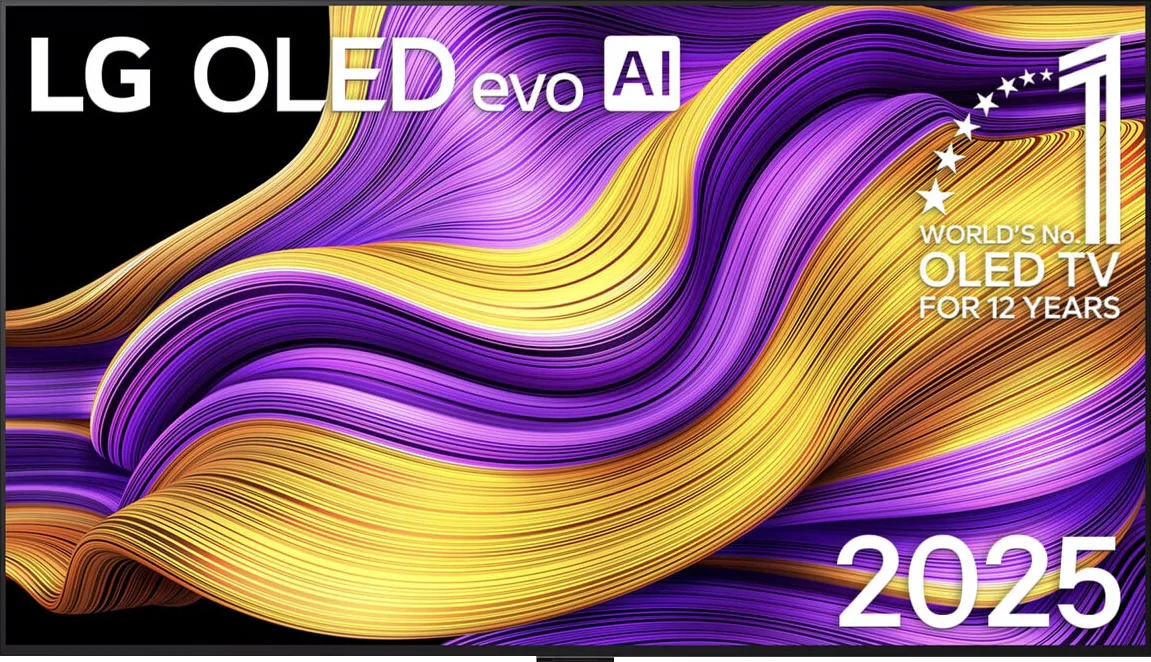
Panel type: WRGB OLED
Resolution: 3840x2160
System: WebOS
Model year: 2024
Complete the survey to find out the result

Panel type: WRGB OLED
Resolution: 3840x2160
System: WebOS
Model year: 2025
Complete the survey to find out the result

Overall rating
8.2
8.9
Movies and series in UHD quality
8.2
9.2
Classic TV, YouTube
8.8
9.2
Sports broadcasts (TV and apps)
8.6
9.0
Gaming on console
9.3
9.6
TV as a computer monitor
8.6
8.8
Watching in bright light
5.7
8.0
Utility functions
8.9
8.5
Apps
9.1
9.1
Sound quality
7.5
8.7
Complete the survey to find out what fits your preferences
Advantages
High efficiency in HDR materials
Very good colour reproduction after calibration
Faithfulness of image with directorial vision
Excellent collaboration with consoles and PCs - low input lag, multitude of conveniences
Advanced motion smoothing system
Amazing black and contrast
Reference colour reproduction after calibration
Very high brightness in HDR content
Excellent compatibility with consoles and computers
Great motion smoothness - OLED panel 165Hz
Many features for gamers: VRR, ALLM, HGIG, low input lag
Great WebOS operating system with many applications
Superb control with the Magic remote featuring a "cursor" function
Disadvantages
Sometimes visible tonal transitions
No support for DTS audio format
Inferior (though still good) viewing angles compared to the predecessor G4
Different remote versions in derivative models – hard to predict which version we will get
Our verdict
LG G5 is a television that not only continues but also expands on what we loved about the previous models in the G series. Instead of following the conventional path, LG opted for a new Tandem OLED panel – and it hit the mark. Picture brightness? Simply, F E N O M E N A L. HDR effect? Close to reference. Colours after calibration? Nearly perfect. Motion smoothness, low latency, and features for gamers? At absolutely top-notch level. The G5 performs well in both movies and games, day and night, with a decoder, console, PC, or even just the remote. Of course – it’s not a product without flaws. It's a shame there’s no support for DTS, viewing angles have worsened compared to its predecessor, and the remote may vary depending on the version. But when we look at the overall picture, it's hard not to get the impression that this is one of the best OLED televisions available on the market, and perhaps even the best. Definitely, when it comes to its versatility and picture quality without the need to resort to extremely expensive models from competitors. If you're looking for a television for everything – for cinema, gaming, a bright lounge, streaming internet content, or connecting a computer – the LG G5 is gear that simply delivers on every front without compromise.
TV appearance




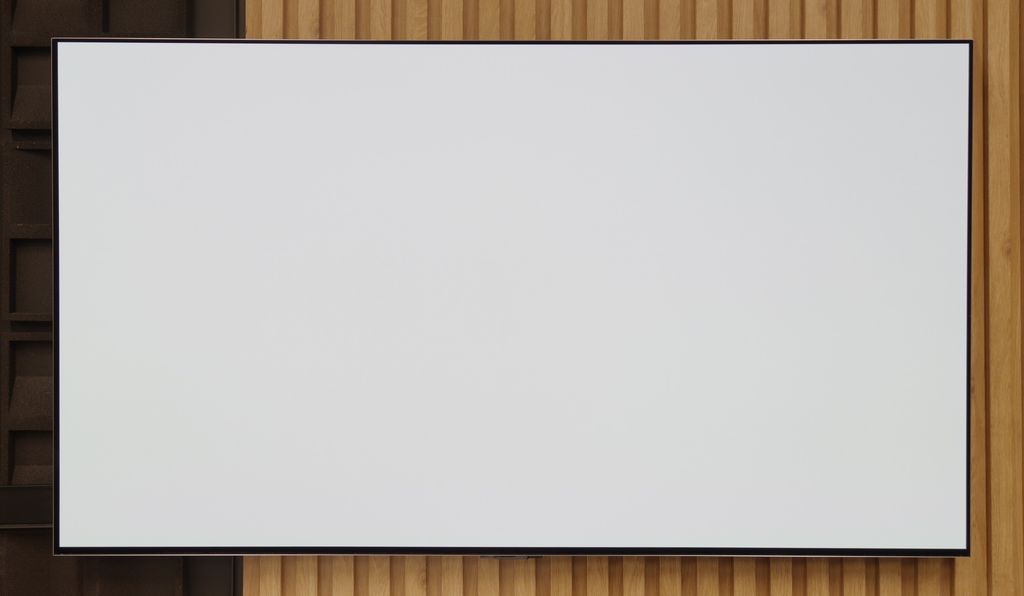
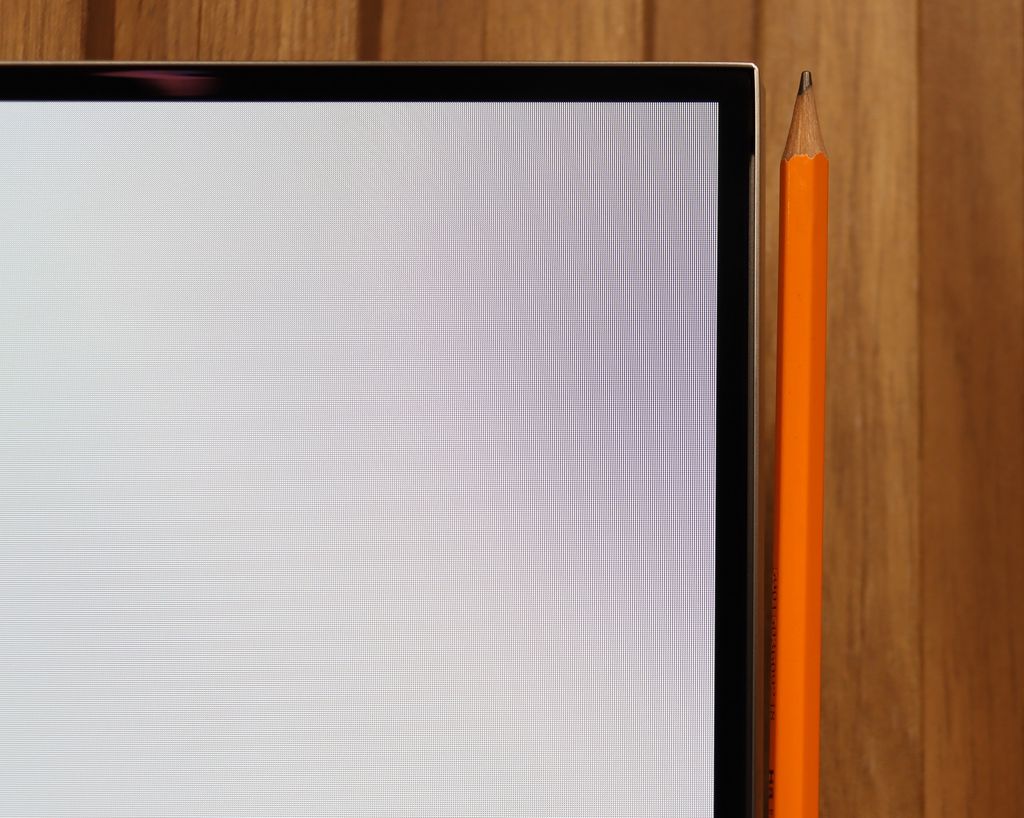
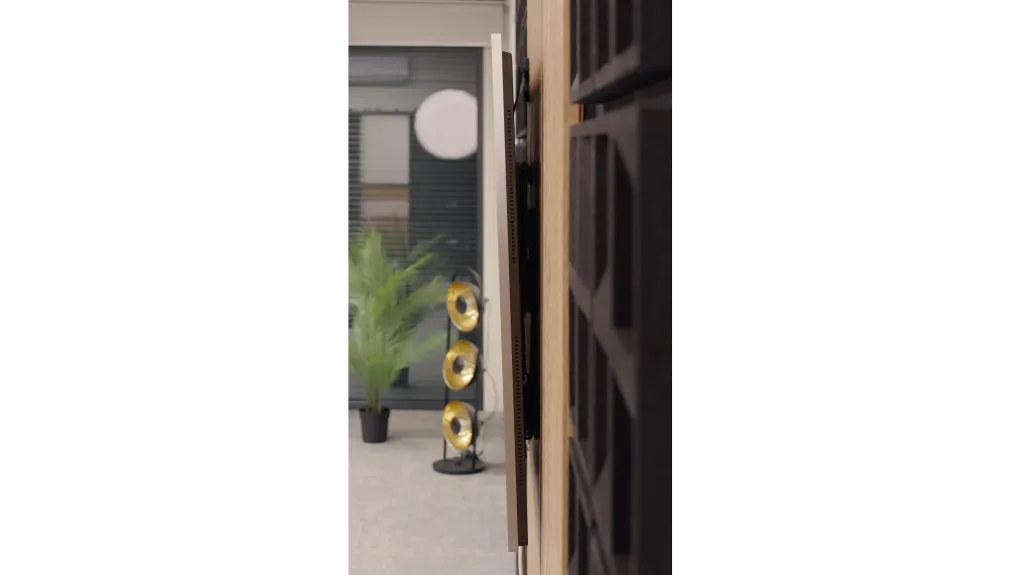
Contrast and black detail
10/10
10/10
Contrast:

Result
∞:1

Result
∞:1

Result
∞:1

Result
∞:1

Result
∞:1

Result
∞:1

Result
∞:1

Result
∞:1

Result
∞:1

Result
∞:1
Halo effect and black detail visibility:

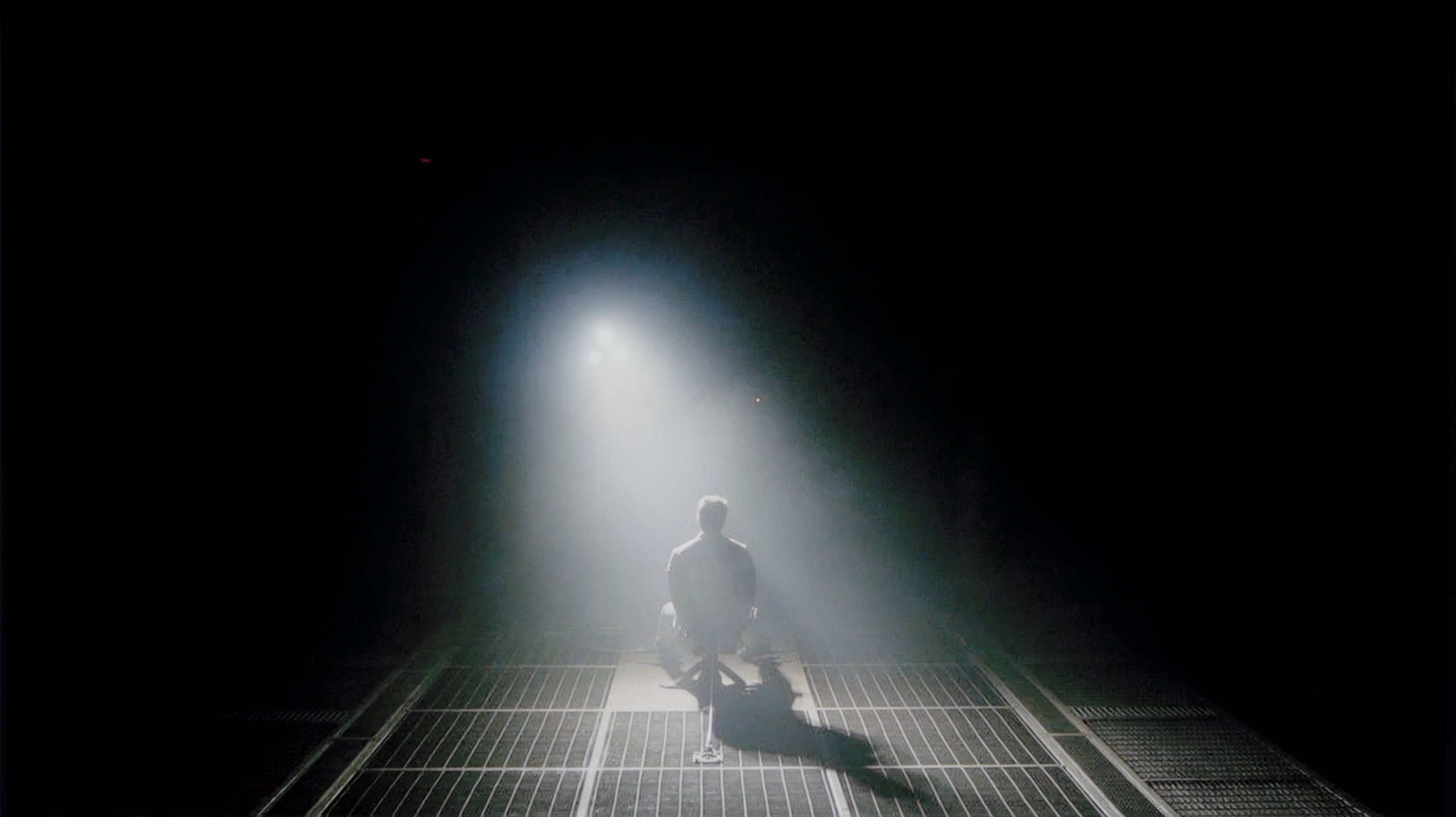
LG OLED C4, as the name suggests, uses an organic panel of its own production. This series definitely belongs to one of the most recognisable on the market. Over 10 years of experience in building self-emissive panels has allowed for the refinement of each subsequent design, with the models from the 2024 range being the quintessence of this process. Of course, the use of this type of screen enables the achievement of flawless contrast and blacks, allowing viewers to immerse themselves in the world created by the director. This is possible thanks to the OLED panel, characterised by the absence of conventional backlighting, which instead allows current to pass through organic pixels. This permits super-accurate image control, thereby eliminating issues such as dimming of delicate fine details or the halo/blooming effect. Looking at both of our test scenes, we can notice two things: perfect light separation and a plethora of details in the movie "Sicario 2".
LG G5, as expected from an OLED television, impresses with its contrast and black levels. In scenes with a lot of dark areas, the screen presents itself almost perfectly, offering deep, absolute black and infinite contrast – an effect that still cannot be achieved on any LCD television. The new Tandem OLED matrix does not introduce any negative changes compared to previous generations – blacks are perfect regardless of the content. Watching scenes from movies like The Revenant or Oblivion, the excellent separation of lights is clearly visible, without blooming or lightening of dark parts. In this category, LG G5 deserves the highest rating.
HDR effect quality
6.8/10
9.1/10
Luminance measurements in HDR:

Result
796 nit

Result
772 nit

Result
869 nit

Result
837 nit

Result
604 nit

Result
2346 nit

Result
2353 nit

Result
2399 nit

Result
2353 nit

Result
2012 nit
Scene from the movie “Pan” (about 2800 nits)


Scene from the movie “Billy Lynn” (about 1100 nits)


Static HDR10


Dynamic: Dolby Vision
Dynamic: Dolby Vision


HDR luminance chart:
LG OLED G5
HDR luminance
Luminance of RGB colors
LG OLED C4
HDR luminance
Luminance of RGB colors
The results of HDR materials are definitely among the better ones. Practically every film significantly exceeds the 700 nits barrier, which allows for a very realistic image. Of course, none of them surpasses the magical thousand, however, the combination of such results along with unlimited contrast and black effectively boosts the visual outcome. The last of the scenes, featuring a fullscreen sun burst, is indeed less bright than the others, although it still represents a respectable level. It's also worth mentioning the excellent coverage of the DCI-P3 colour palette, which will enable the achievement of exceptionally vivid colours.
LG G5 with its new Tandem OLED panel brings the biggest change in terms of TV brightness. And it’s substantial. This is a truly astronomically bright OLED. In every scene tested – whether it's point lights or full-screen whites from the movie The Meg – brightness on the G5 exceeded 2000 nits. Just a year ago, such values on an OLED were simply unimaginable. And here we are – the G5 is approaching, and at times even surpassing, the best Mini-LEDs on the market. A novelty in the Tandem OLED panel is also the expanded colour gamut coverage – and here the LG G5 performs almost perfectly. DCI-P3 achieves a full 100%, while BT.2020 hovers around 83%. These are some of the highest values currently available on the market – it's hard to find any other TV that comes close to such results, unless we're talking about the best displays with QD-OLED panels. The G5 has almost reference-level HDR quality – both in terms of brightness and colour saturation. This is an OLED that can truly shine – and not just metaphorically.
Factory color reproduction
8.1/10
7.8/10


Factory Mode
After calibration


Factory Mode
After calibration
The best factory mode implemented in the tested television was "Filmmaker". That was the one we used during all tests. This mode, in terms of colour reproduction, turned out to be quite decent, although other flaws effectively detracted from the enjoyment of the viewing experience. Starting with the most basic one, which is white balance, it was easy to notice that this was marked by a dominance of red, which completely altered the characteristics of the picture. We could see a strong yellowing of the whites and a shift of all colours to warmer tones. The gamma, which is a graph as equally important, if not more so, was quite severely reduced, resulting in a significant drop in contrast, except for the start of the graph, where the television insidiously lost details. That’s all regarding SDR materials. Looking closely at films with a wide dynamic range, we can observe exactly the same phenomenon of white balance yellowing as in films with a standard colour palette. The EOTF curve, which replaces the gamma chart for us, is practically perfect and cannot be faulted.
Our test unit LG G5 had some issues in the factory Filmmaker mode. While the picture might have seemed fine to most people, we knew this TV could do much more. This mode had a noticeable excess of blue tint in the white balance, resulting in a strongly cooled image – especially in HDR modes, where there was additionally a lack of red. The image appeared cold, and its sharpness was artificially boosted and unnatural. Another significant problem was the brightness characteristics. In SDR content, the situation wasn't the worst, aside from a slight dimming of the entire image. However, it fared much worse in HDR materials – due to improper brightness management, the smallest details could completely disappear from the image, while larger, bright elements looked overexposed and lacking in gradation. Fortunately, the G5 supports calibration using 3D LUT (a professional tool for colour calibration), so we decided to take advantage of its professional capabilities and see what it was really capable of. Because while it wasn't terrible even before calibration, the potential of this TV definitely deserved more.
Color reproduction after calibration
9.5/10
9.8/10




As we mentioned earlier, LG televisions are equipped with advanced tools for carrying out the calibration process. We used them to model the picture in line with what the director envisioned. And without modesty, we must admit that we achieved this phenomenally. Both SDR and HDR materials present a level that clearly indicates this is how a film should look. It's worth taking a look at the colour errors on the "ColorChecker" palette, where practically none of them exceed "1", except for two samples.
After completing the calibration process with professional tools, we can confidently state this – the LG G5 offers almost reference-quality image. Most of the errors related to white balance and the ColorChecker test are below a value of 2, which is a phenomenal result, practically imperceptible to the human eye. And while one could still nitpick that in HDR films the TV still has a tendency to slightly dim the smallest elements of the image, in practice this does not negatively affect the overall reception. Hats off to LG, as once again they provide users with enormous display settings options – and this, combined with very good parameters of the panel itself, results in an image that is truly hard to beat.
Smoothness of tonal transitions
7.1/10
8.5/10












The fluidity of tonal transitions in LG televisions has always been a rather sensitive issue, as the manufacturer, despite impeccable performance in other areas, has almost always struggled to get this right. The evaluation results for the fluidity of tonal transitions in the tested television were quite good, with issues mainly visible in darker scenes, such as the last two scenes. Interestingly, this is a significantly better result than the highest model from the manufacturer, namely the LG G4.
The fluidity of tonal transitions in the LG G5 is a clear step forward compared to last year's model. Not only has brightness improved, but also the way colours blend, which the G4 sometimes struggled with. In the vast majority of scenes, the G5 has no issues with tonal transitions – there’s no typical banding associated with WOLED technology nor any ugly breaks between colours. Of course, in very dark areas of the image and with shades of grey, small imperfections can still be noticed, but these are things that the average viewer wouldn't even register. In short – it's really good.
Image scaling and smoothness of tonal transitions
8/10
8.7/10
Smooth transition function

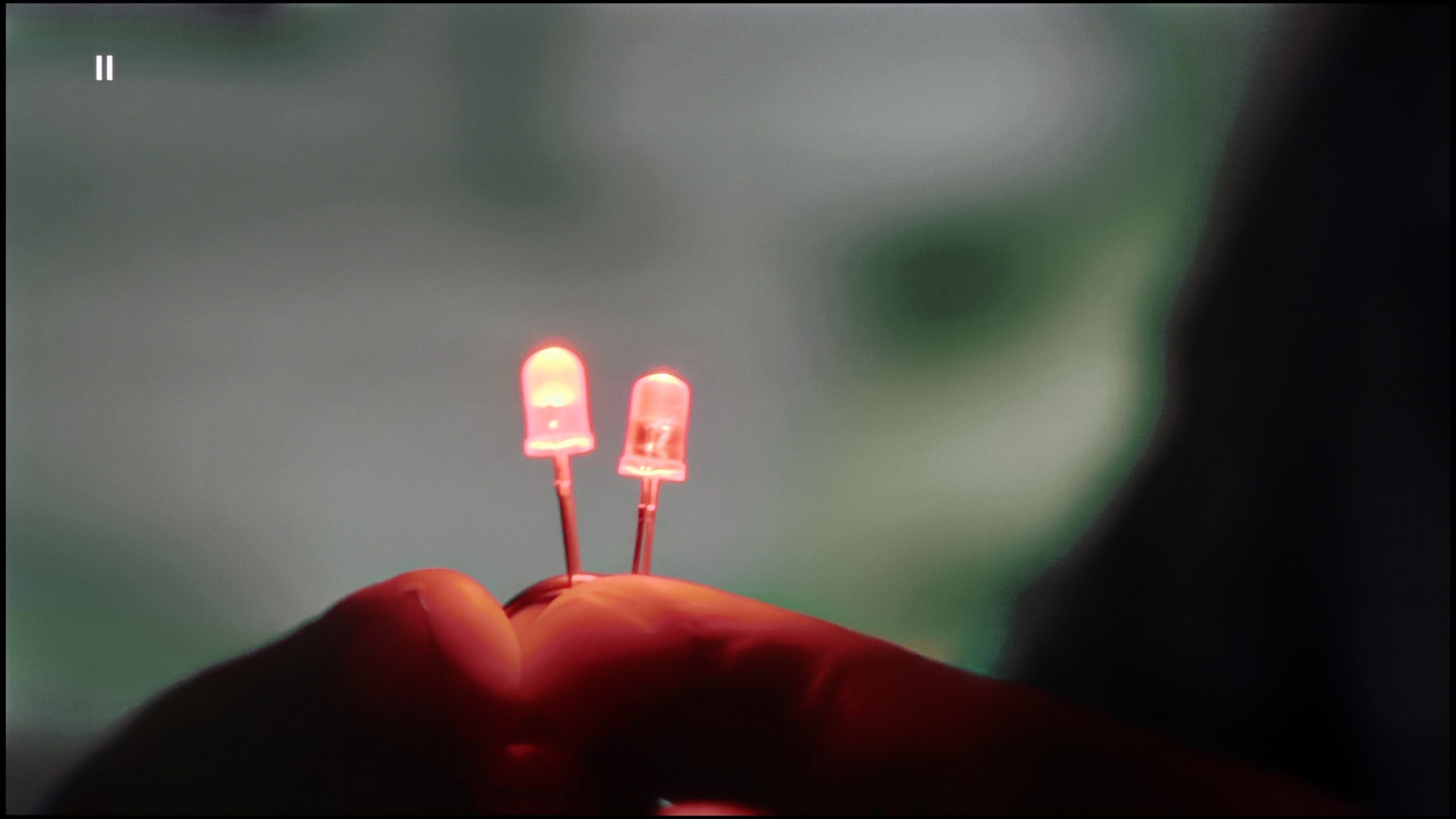
Image without overscan on the SD signal


Once again, we will take a look at the feature responsible for gentle gradation, but we will also address the one that aims to enhance the quality of lower-quality materials. The default smoothing of tonal transitions, as we could see, was not the worst, but it can be improved further. The function has a slider that allows us to adjust its intensity. We recommend using the former, as it produces very good results and does not blur important details.
Image scaling on LG C4 is quite good, however, it cannot be said to be without flaws. The image is slightly sharper by default, although not in a very noticeable way. While jagged edges of trees can be seen, it is not a major issue when compared to other manufacturers.
Upscaling and digital image processing in the LG G5 performs very well. The television handles lower quality content excellently, especially when the "Smooth Gradation" feature is set to a low level. In this mode, it effectively removes undesirable artifacts and issues with visible tonal transitions. It may also slightly smooth out some desirable details, like the subtle texture of clothing or skin, but importantly – it does not remove film grain, so it's hard to talk about a serious compromise here. This is one of those options that is actually worth turning on.
The G5 also does well with upscaling, which is improving the quality of older materials. The test image with the model looked really solid – slight jaggedness was visible, but that's an effect that can't be completely avoided. On the plus side, there were no overscan issues, which – contrary to appearances – is not obvious, even in 2025.
Blur and motion smoothness
8.5/10
9/10

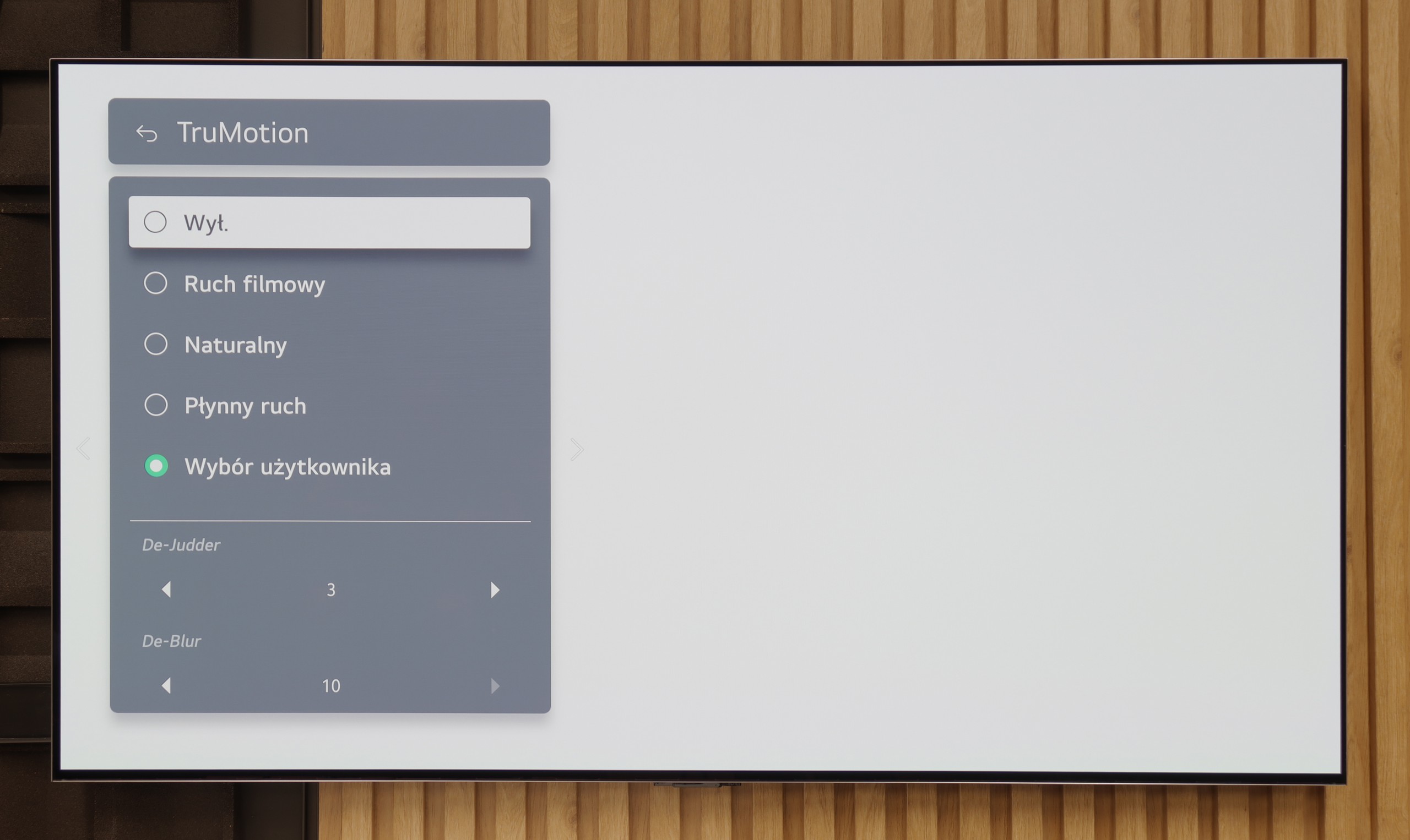
Blur (native resolution, maximum refresh rate):






Blur (BFI function enabled):
Image flickers in this mode



Image flickers in this mode



Smużenie ():
Smużenie (4K 165Hz):



The maximum refresh rate we can set on the LG G4 is 144 Hz. Naturally, this is only possible when connecting the TV to a very powerful PC. Otherwise, we will operate at a maximum refresh rate of 120 Hz, which is recommended if we primarily want to watch sports or content with a lot of motion dynamics. For those who require high fluidity of the image, the manufacturer has implemented a multi-level motion smoother called "TrueMotion". It has been divided into two separate sliders that adjust the sharpness of moving images (De-Blur) and judder (De-Judder). Both sliders can be set in the range of 0 to 10, with each degree affecting the level of smoothing, allowing everyone to find their sweet spot.
The panel of the LG OLED C4 features an average response time of less than 1 ms (which directly results from our measurements), enabling the achievement of an extremely clear image, unattainable for LCD TVs, which can have response times of up to several milliseconds. This is clearly evident in the images from the "UFO Test," which show no trailing blur behind the object.
The motion smoothness on the LG G5 is simply phenomenal. The television is equipped with a panel featuring a 165 Hz refresh rate, and this combined with the instantaneous response time of the OLED matrix delivers incredible results. The image doesn’t judder or blur like on traditional LCD televisions. Like most LG models, the G5 comes with a motion smoother, which can be handy when watching movies – we’re talking about the TruMotion mode, of course. With the “De-Blur” and “De-Judder” sliders, we can adjust the smoothness of older materials according to our own preferences, whether we want to maintain the characteristic film jitter or lean towards a more fluid, television-like effect.
Console compatibility and gaming features
10/10
10/10
- ALLM
- VRR
- VRR range40 - 144Hz40 - 165Hz
- Dolby Vision Game Mode
- Correct implementation of HGIG
- 1080p@120Hz
- 1440p@120Hz
- 4K@120Hz
- Game bar

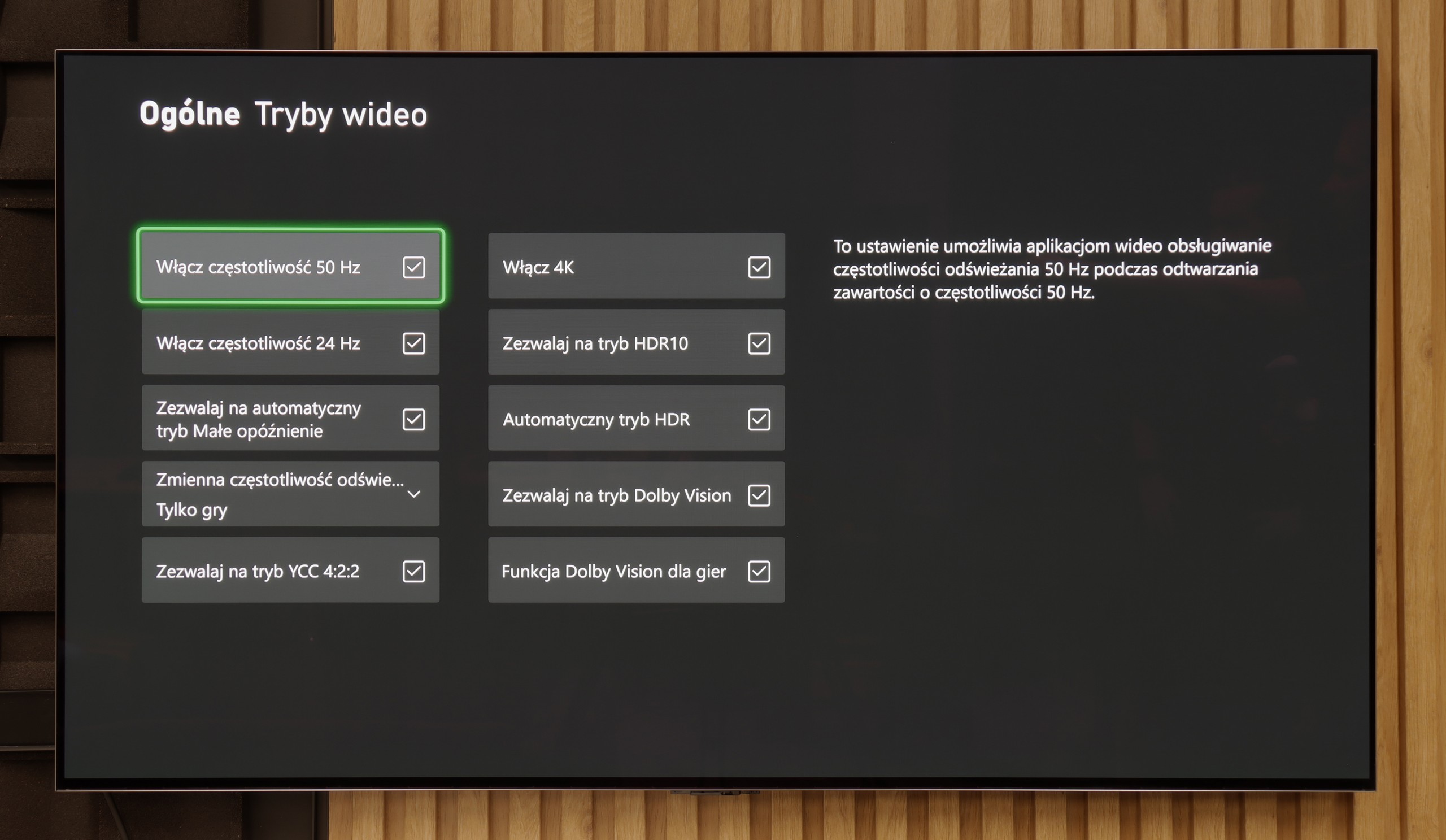

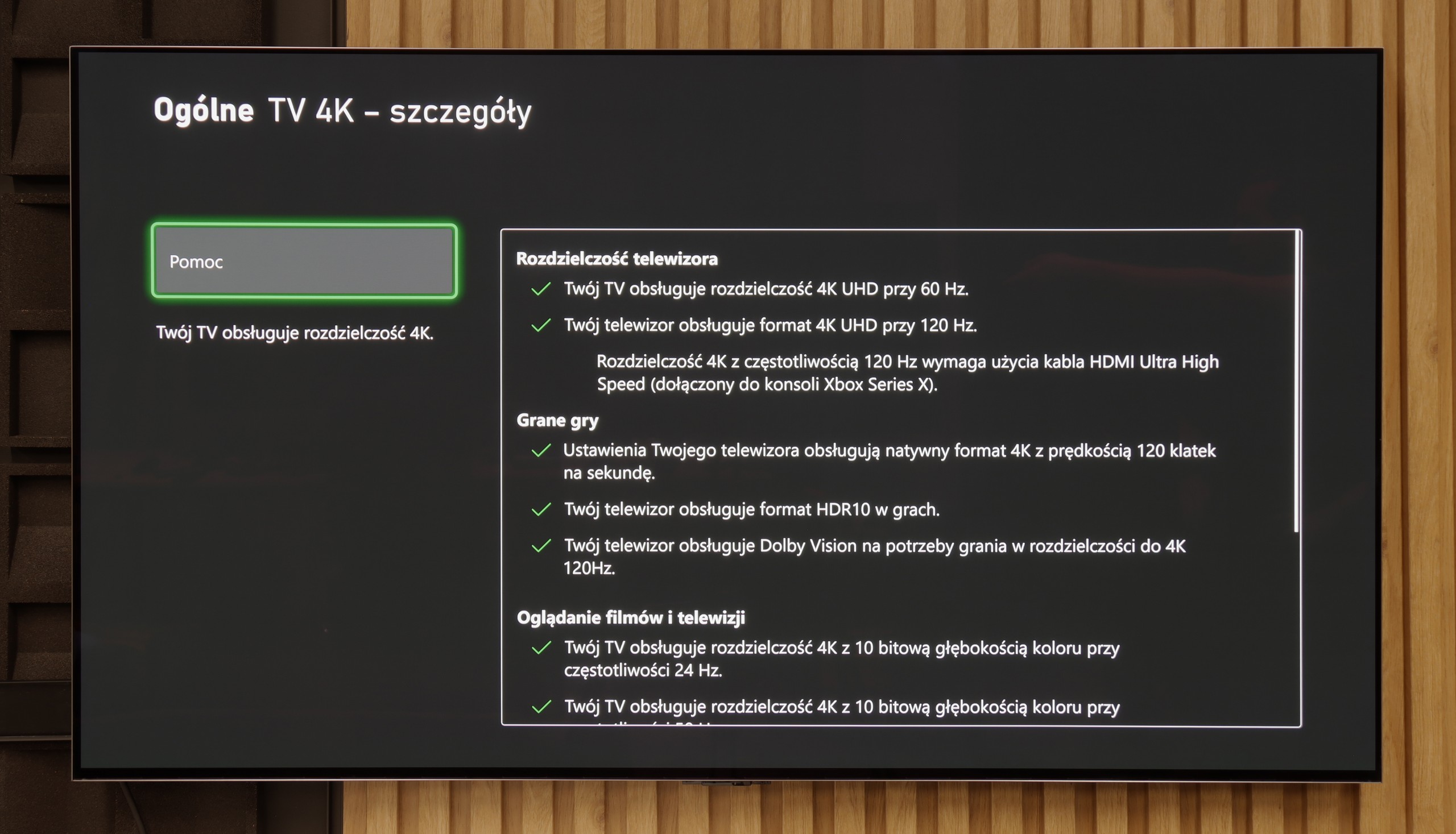

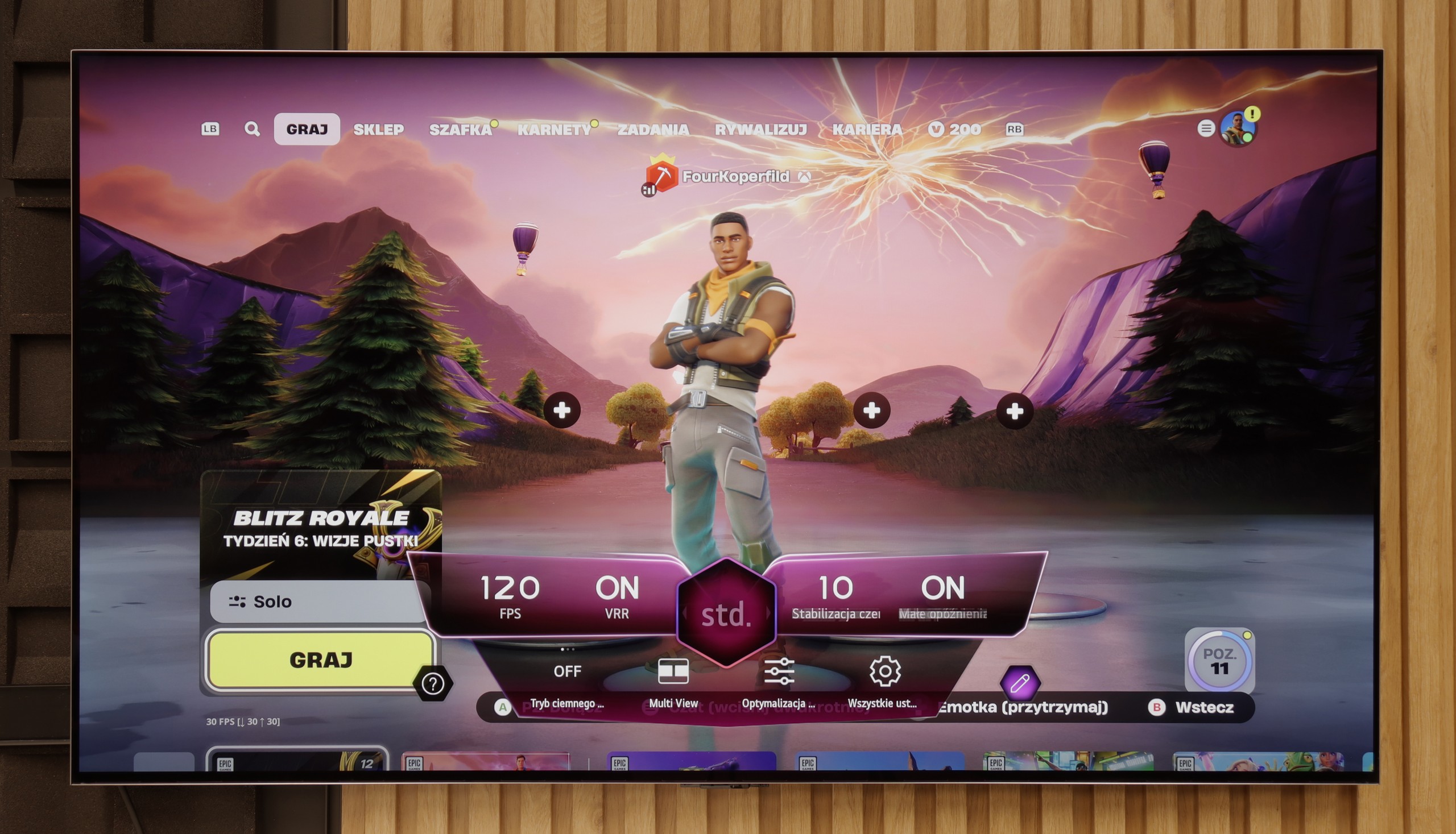

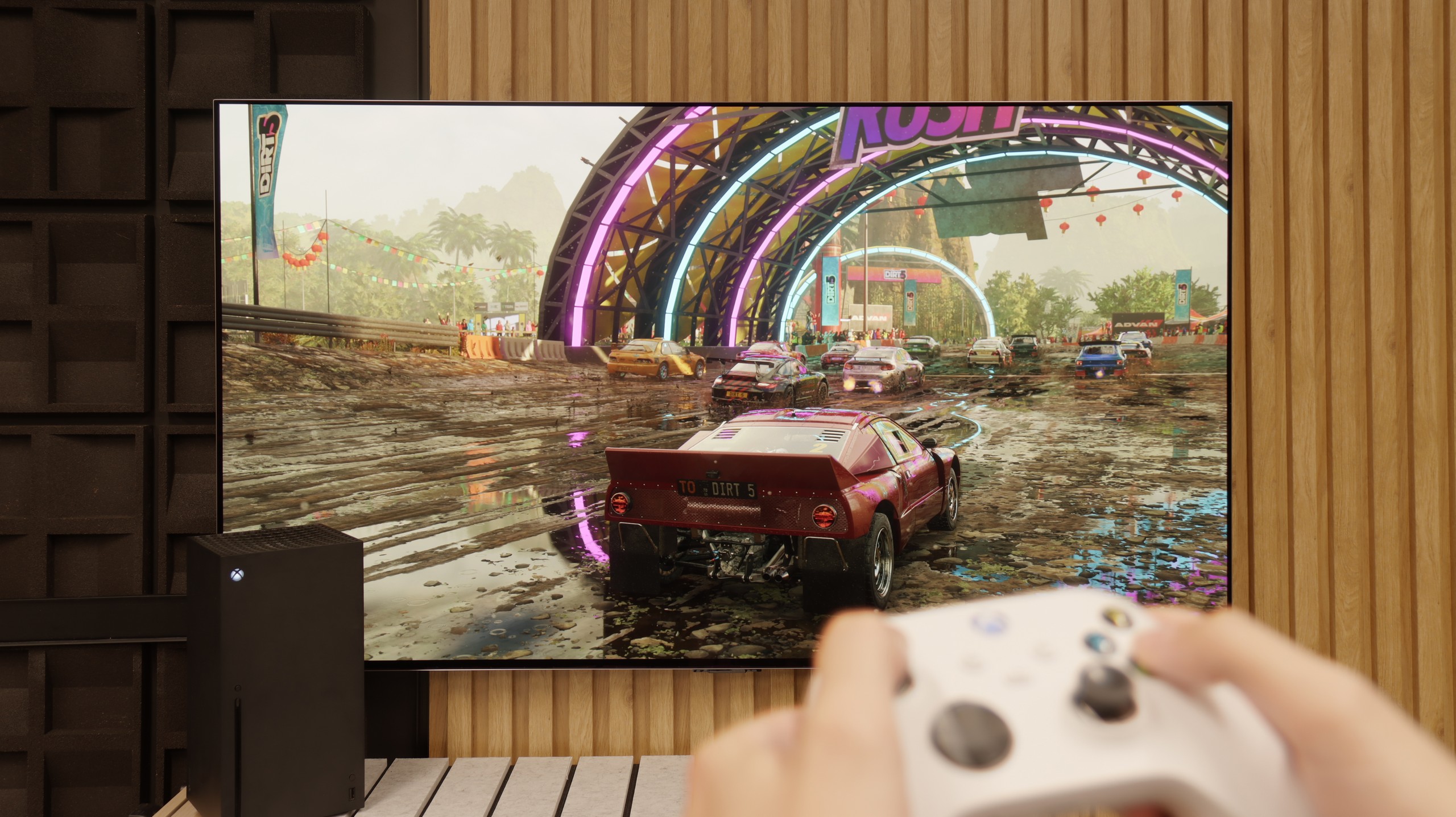
We can now say that LG C4, like practically every OLED television from the manufacturer, is exceptionally good in terms of cooperation with consoles and PCs. Thanks to the implementation of four full-bandwidth HDMI 2.1 ports at 48 Gbps, the manufacturer has embedded all the features that enhance gaming comfort, including simultaneous support for FreeSync and G-Sync technologies. With such a tandem, players with graphics cards from AMD or nVidia can safely choose C4. However, what should please gamers demanding the highest possible quality the most is the simultaneous implementation of HDR Dolby Vision and HGIG mode. The former is particularly important as it operates with extremely low input lag in all settings.
A standard feature in televisions from the Korean manufacturer is also the implementation of GameBar, allowing for quick adjustments of settings "on the fly," without the need to exit the game. It also allows for image adjustments for people with visual impairments, which is an incredibly nice touch. Another important piece of information is that when VRR technology is enabled, we won’t experience a drop in contrast. This is, of course, due to the design of the panel and the absence of conventional backlighting. It is, however, normal for shades of grey to flicker slightly, although this is a characteristic feature of this function regardless of the manufacturer and television.
In summary: LG C4, just like all the manufacturer's OLEDs equipped with high-refresh-rate panels and HDMI 2.1 connections, creates a harmonious whole with consoles. In practice, it is a complete television, and if we expect the highest possible efficiency in gaming, C4 will be an ideal choice.
Features for gamers? Perfect. That should be enough for you to know what level we’re dealing with here. The G5 is a TV designed for gamers, so you'll find literally everything you might expect from a gaming screen. There's Game Bar, support for high resolutions with high refresh rates - that is, 4K at 120 Hz, and even more, as the panel has a refresh rate of 165 Hz (which PC gamers will benefit from). The TV supports variable refresh rate (VRR), automatic low latency mode (ALLM), and also properly handles HDR in games thanks to the HGiG feature. All of this adds up to one of the best gaming feature sets available on the market. Well done, LG.
Input lag
10/10
9.9/10
SDR
HDR
Dolby Vision
The latency time of LG C4 is remarkably low in every scenario. Even the most avid gamers will surely appreciate the very low input lag at demanding 4K 120 Hz settings with HDR, which is only 5 ms. It's also worth noting that the lag at these same settings, but with Dolby Vision HDR enabled, remains unchanged, which is not so obvious with the competition. Therefore, it deserves the highest rating and recommendation.
The input lag on the LG G5 is incredibly low. The response time to our actions – whether we're gaming with a controller, keyboard, or mouse – is nearly perfect. The controls are instantaneous, and the game reacts exactly when we expect it to. The Dolby Vision Gaming mode does introduce slightly higher latencies, but even then, it's hard to complain about anything – in the worst case, the values hover around 20 ms, which will still be virtually unnoticeable for most gamers.
Compatibility with PC
8.6/10
8.8/10

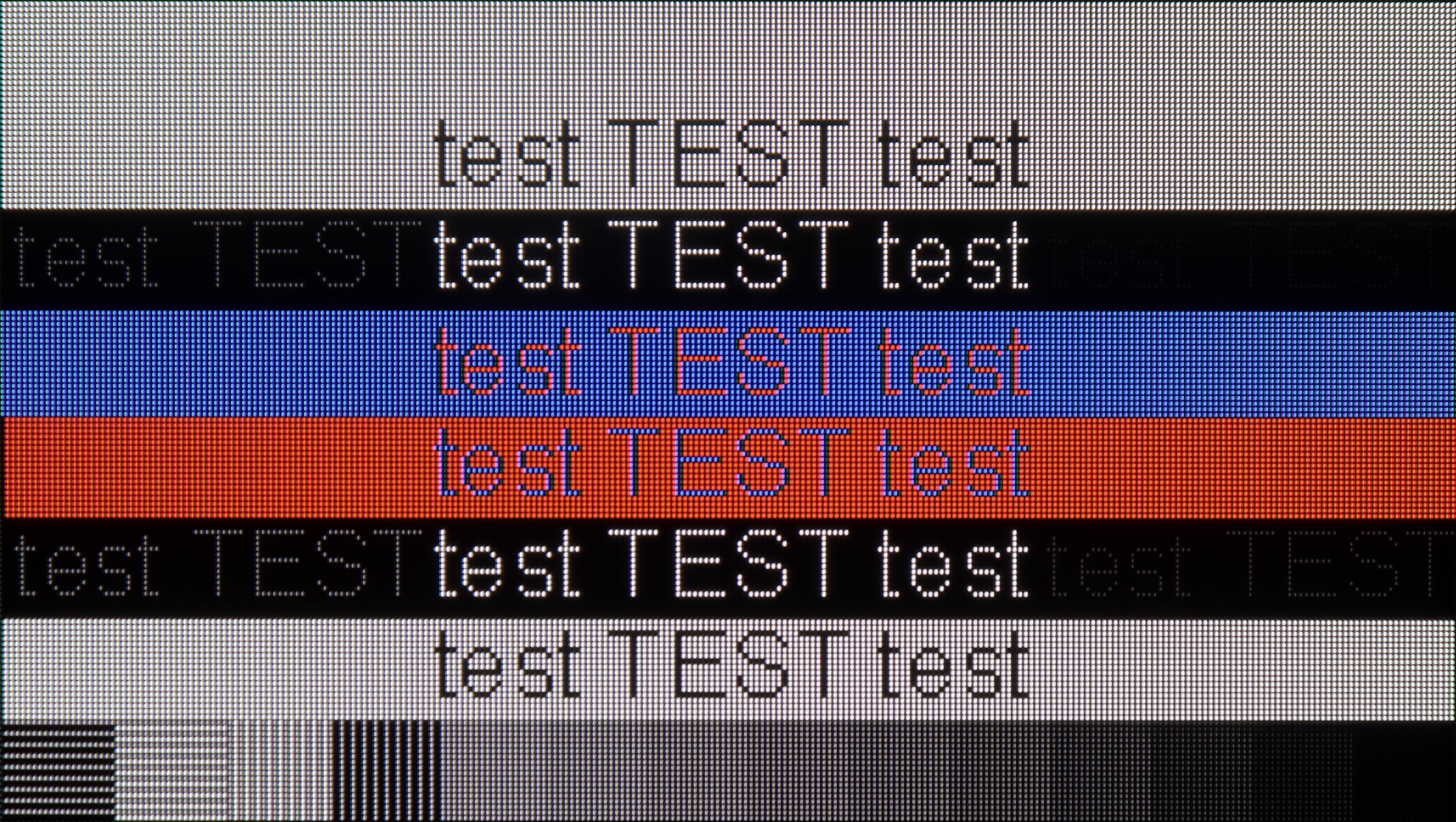
LG C4 combined with a PC works wonderfully, thanks to its very low latency of just 13.5 ms, which is practically instantaneous feedback between the mouse, eye, and screen. An extremely important aspect when working on a screen is the readability of text, which in the case of the tested TV is very good. However, it is worth noting that to achieve sharp fonts, you need to enable the passthrough option in the settings.
The RWBG pixel layout does not significantly affect the display of fonts or letters, which is a significant advantage over Samsung's QD-OLED panels. Users of both Windows-based PCs and macOS will surely be pleased with their experience on the tested TV screen.
Cooperation with a PC? Almost perfect. The television, as mentioned earlier, has great features for gamers – including those using a PC. Onboard, we find full G-Sync certification, a 165 Hz panel, and super-fast input lag at around 5 ms. Thanks to proper implementation of chroma 4:4:4, fonts are very readable – both the smallest and the largest. Although due to the WRGB subpixel layout, there may be slight shadows around the characters, for most users this effect will be practically unnoticeable. The G5 performs excellently as a screen for work, entertainment, and gaming – also from a computer.
Viewing angles
7.5/10
7.5/10
The undisputed advantage of OLED panels is their efficiency in the context of group viewing, meaning from various angles. LG C4 maintains very good contrast, colour saturation, and fidelity. Although this isn't a result of organic TVs supported by MLA technology, it's fair to say that anyone who purchased the device was satisfied with the results obtained. However, it should be noted that at sharp angles a slight greenish tint can be observed. This is a characteristic feature of WRGB panels from LG, without the aforementioned micro-lens technology, and unfortunately, there's nothing that can be done about it.
The viewing angles on the LG G5 are very good, primarily due to the use of a WOLED panel. It's hard to find fault here – the picture doesn't significantly lose brightness or quality even when viewed from the side. However, it must be noted honestly that there has been some regression compared to the G4 model. The predecessor used an MLA panel with micro-lenses, which offered slightly better light distribution. Also, compared to QD-OLED panels, the angles are worse. Nevertheless, the overall viewing experience at an angle remains very good and shouldn't be an issue for everyday use.
TV efficiency during daytime
5.7/10
8/10

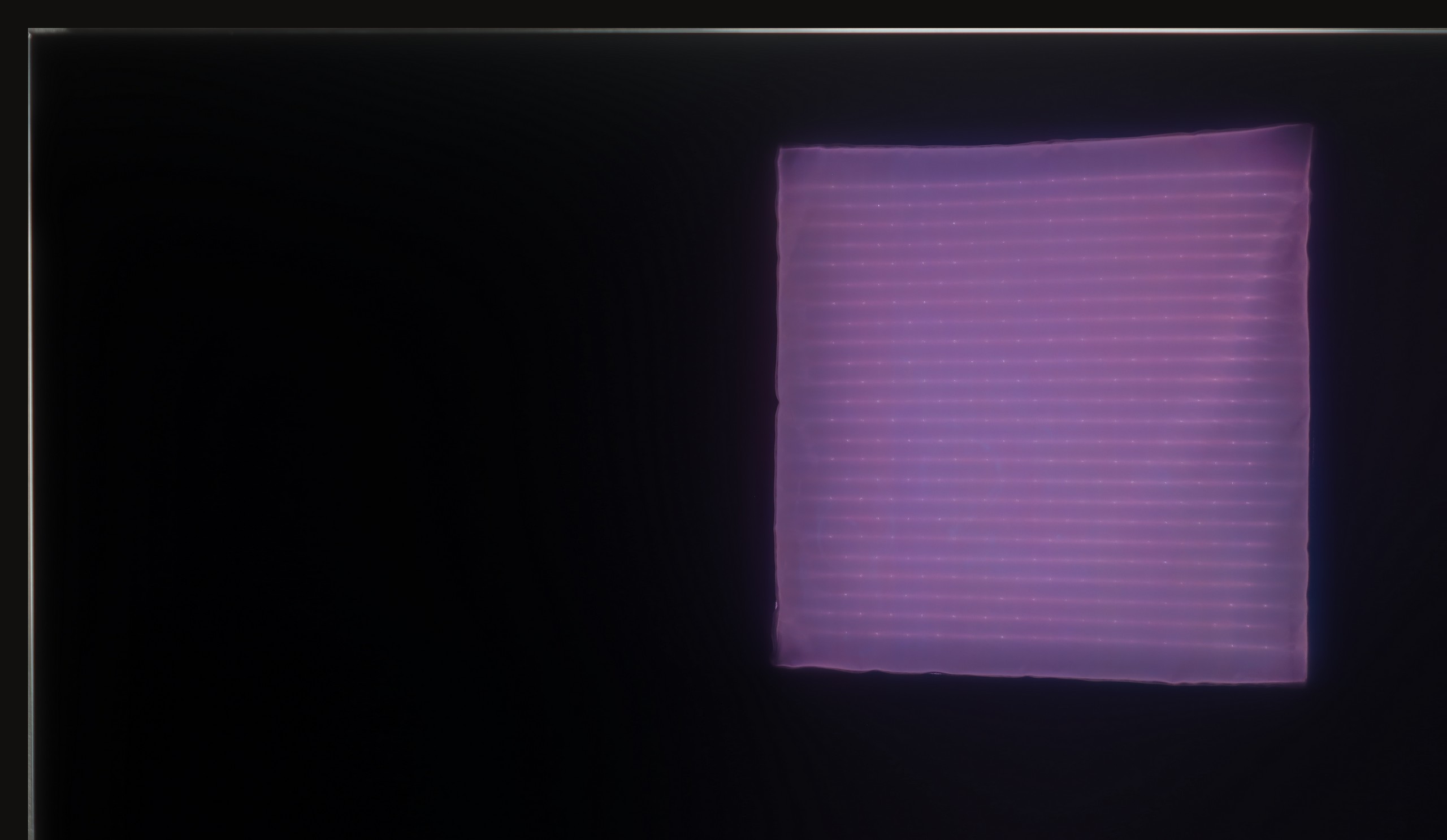


Matrix brightness
Average luminance SDR
LG OLED G5: 810 cd/m2
LG OLED C4: 367 cd/m2
The maximum brightness of the television in SDR materials is 367 nits. For an OLED television, this is a very good result and allows for quite comfortable viewing during the day. It's worth noting two things. Thanks to the glossy coating of the panel, the light reflections are well held in place and do not spill over the rest of the panel. The second issue is the brightness of the screen when fully filled with white, oscillating around 220 nits, which is a remarkable result, as until recently, OLED televisions in this category could only boast brightness half as much. As a result, the conditions for watching, for example, winter sports will be very good.
LG G5, with its very high brightness, performs excellently in bright rooms. Even with SDR content, the average brightness is around 800 nits, significantly more than standard televisions. It will handle a bright living room with ease. Although the panel moderately reduces reflections, it still maintains much better blacks and colours during the day than QD-OLED panels or those with a matte finish. The G5 will work effortlessly in very sunny rooms – unless you really can’t stand reflections on the screen. In that case, you’ll need to use blinds or consider purchasing a television with a matte panel.
Details about the matrix
Subpixel Structure:

Panel uniformity and thermal imaging:


TV features
8.9/10
8.5/10
- HDMI inputs0 x HDMI 2.0, 4 x HDMI 2.1 48Gbps0 x HDMI 2.0, 4 x HDMI 2.1 48Gbps
- Other inputsIR (remote)
- OutputsToslink (Optical audio), eARC (HDMI), ARC (HDMI)Toslink (Optical audio), eARC (HDMI), ARC (HDMI)
- Network InterfacesWi-Fi 2.4GHz, Wi-Fi 5GHz, Ethernet (LAN) 100MbpsWi-Fi 2.4GHz, Wi-Fi 5GHz, Ethernet (LAN) 100Mbps
- TV receptionDVB-T, DVB-T2, DVB-S, DVB-S2, DVB-CDVB-T, DVB-T2, DVB-S, DVB-S2, DVB-C
Classic features:
- Recording to USB (terrestrial TV)
- Recording programming
- Picture in Picture (PiP)
- RF remote control (no need to aim at the screen)
- Backlit remote control
- Teletext
- Audio only mode
- Bluetooth headphones support
- Simultaneous Bluetooth headphones & TV audio
Smart features:
- AirPlay
- Screen mirroring (Windows Miracast)
- Voice search
- Voice search in native language
- Ability to connect a keyboard and mouse


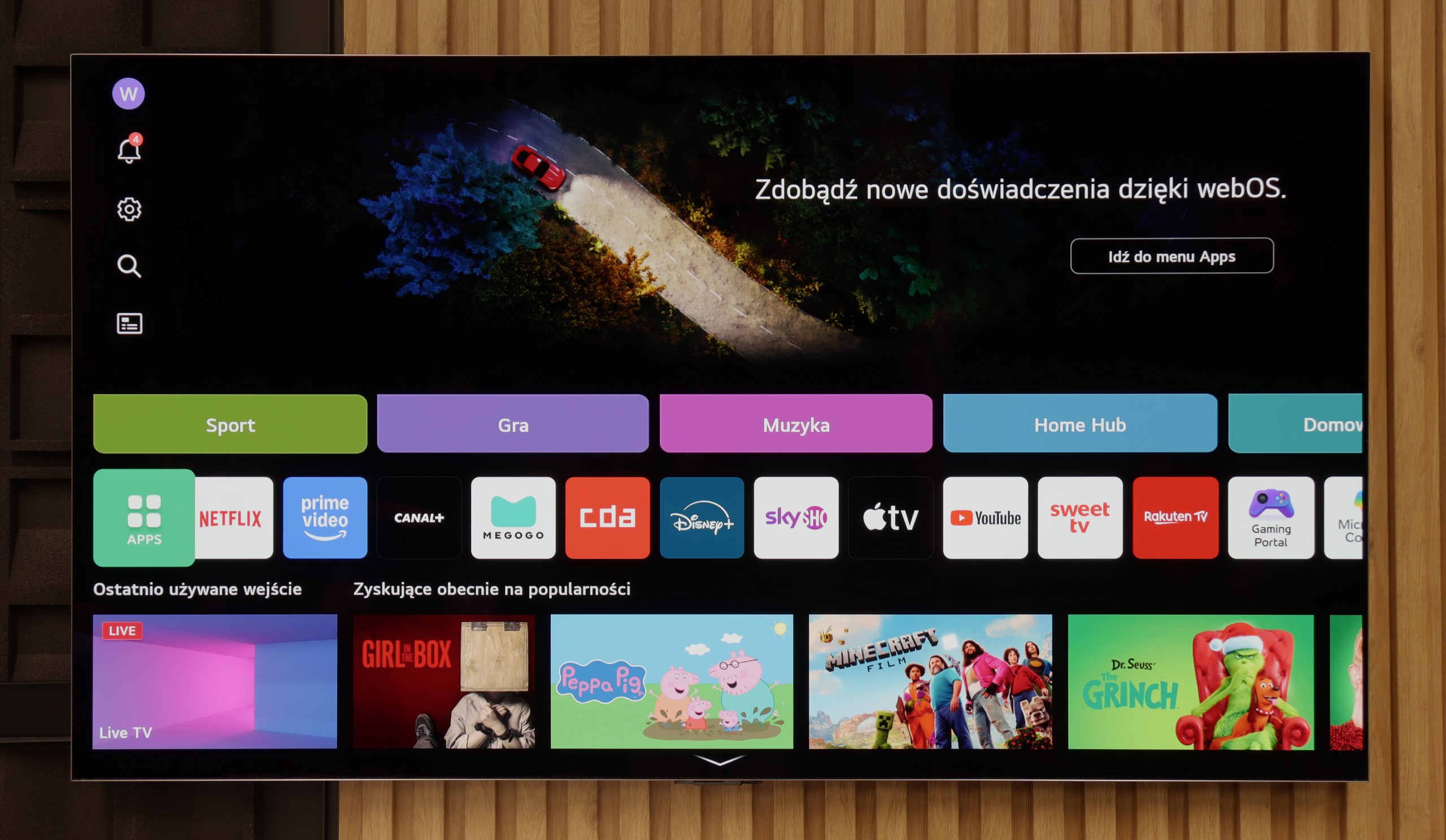
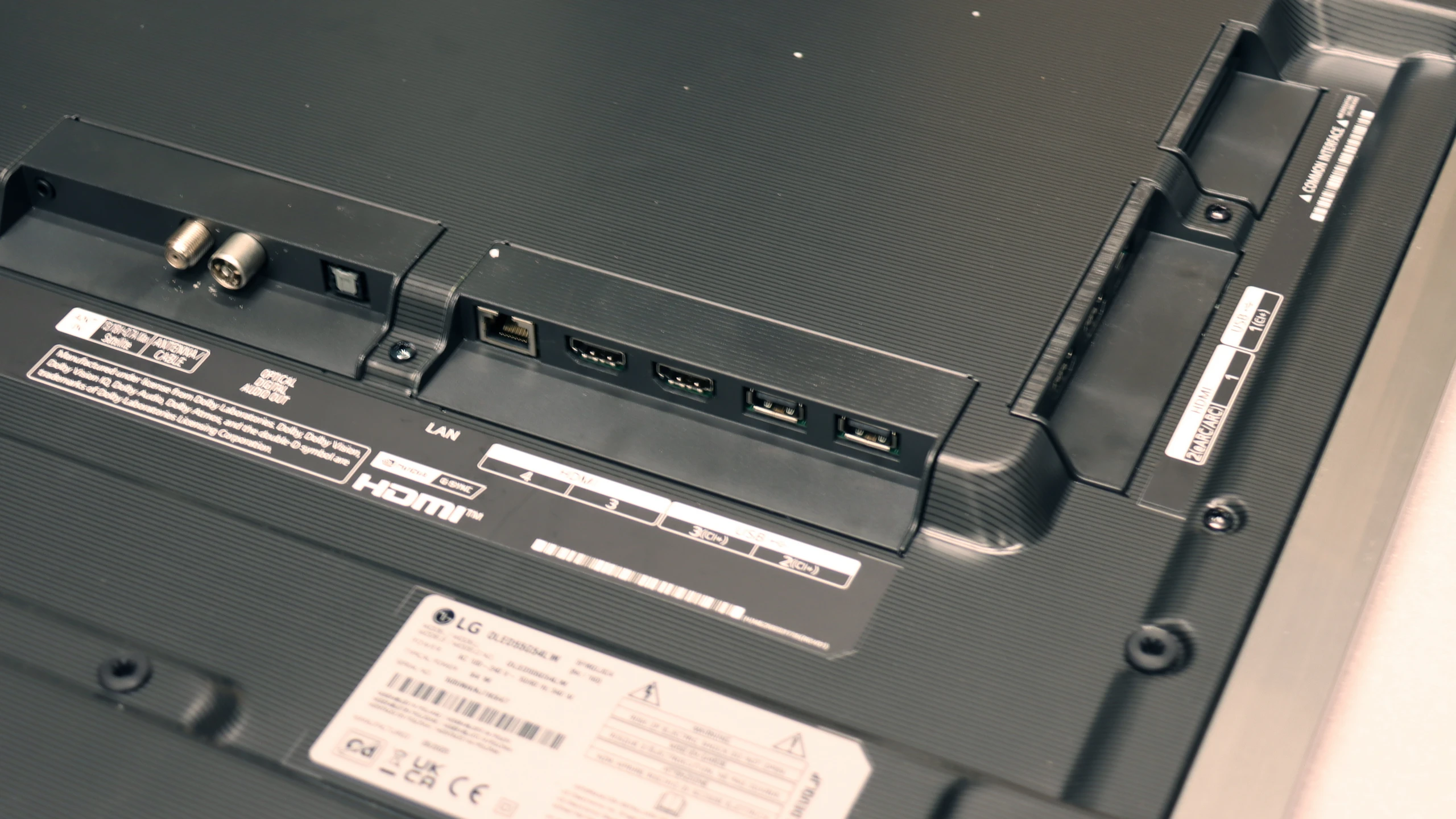
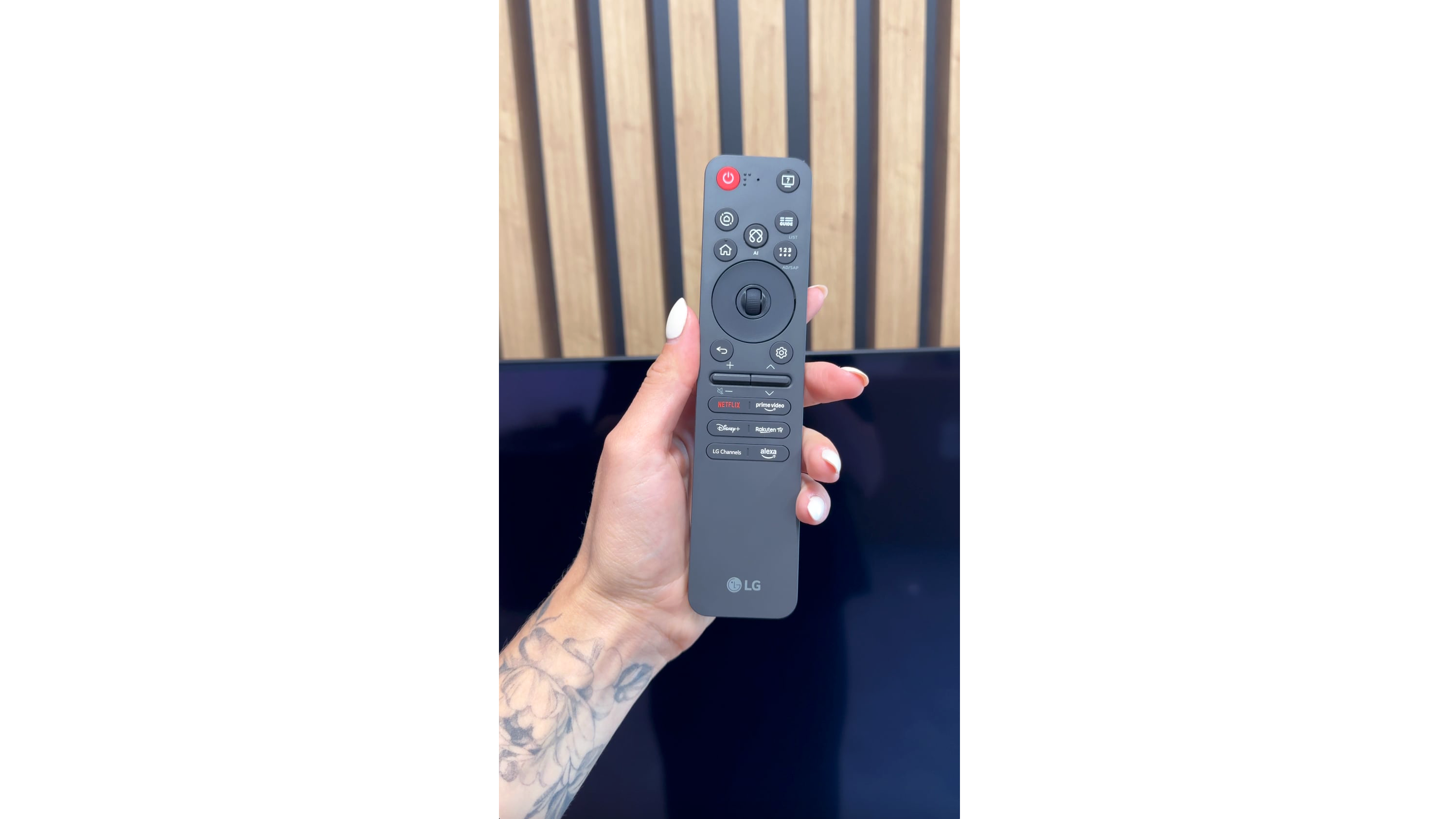
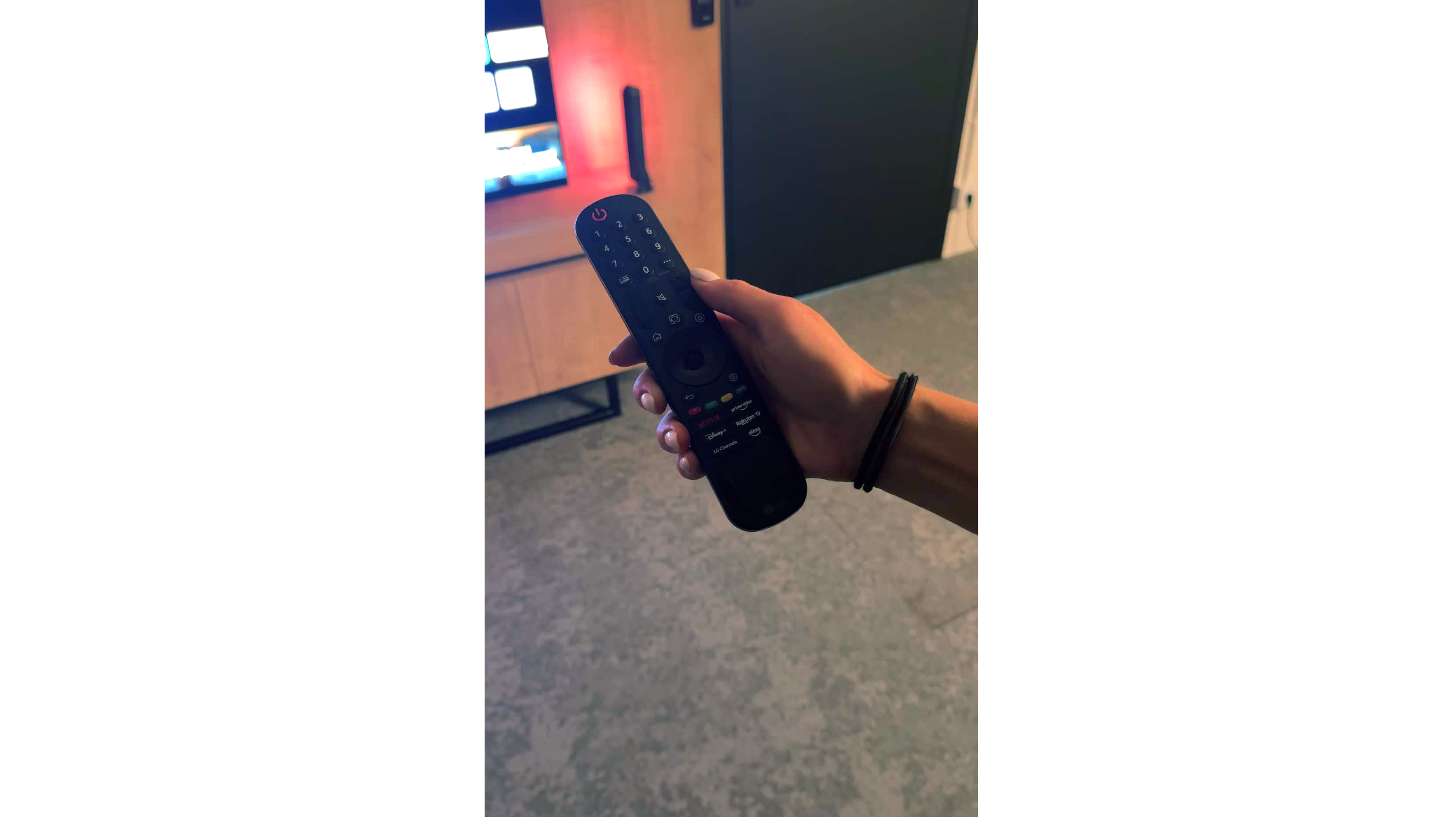
LG uses the well-known proprietary WebOS system that has been around for many years. The system offers virtually all the major apps, and the few that are missing can be counted on one hand, such as CDA or KODI. It's also worth noting that the modern web browser and the remote with a built-in mouse allow for convenient access to streaming services in this way, if there isn't a built-in app.
WebOS also features a highly praised ability to perform operations using a cursor that appears when the remote is moved. The convenience of this function is invaluable when entering queries or passwords for portals. WebOS, like most systems, also supports features such as screen mirroring, AirPlay, voice searching in Polish, and the ability to connect headphones via Bluetooth. On a more practical note, WebOS allows simultaneous use of headphones and the television speaker, which will certainly be a significant help for those with hearing impairments. One of the more interesting features, particularly appreciated by sports fans, is the ability to turn on an alert for an upcoming match, ensuring that we never miss a broadcast. The home panel also deserves praise, allowing for control of all smart devices connected to the home network. For example, the end of a wash cycle will be signalled by a notification in the top right corner.
In summary, the WebOS system, although less known and with certain limitations compared to Android TV, offers stable and quick performance and supports most functions that users may need. It is a solid solution for those looking for a simple and effective operating system in their television.
Classic Features
LG G5 has a lot to offer when it comes to classic television features. Apart from the lack of the ability to watch two sources (PIP), the TV performs excellently for everyday use. There are no issues with connecting external Bluetooth devices like headphones, and the EPG interface is very clear and understandable – even for those who are not particularly tech-savvy.
Smart TV Features
The Smart TV in the G5 operates on the WebOS system – it is the heart and brain of the entire television. With the Magic remote, using the G5 is truly enjoyable. We control the cursor on the screen with wrist movements, which resembles using a mouse in the air. The system itself is very sophisticated and offers everything one could expect: AirPlay, screen mirroring, voice search, and voice commands – all of which work smoothly and without delays. There’s no doubt it’s one of the best operating systems in TVs on the market.
Note:
During our tests, we had almost nothing to complain about – maybe aside from one exception: the confusion surrounding the remote. Depending on the market and the specific version of the model, you may encounter the new, minimalist Magic remote (without a numeric keypad), or the older version with a full set of buttons. We tested the G54LW model, which had the new Magic remote, but it’s hard to say how the situation looks in other variants. It may be a similar situation to the LG C5 series, where the remote attachment also depends on the specific market.
Playing files from USB
9.3/10
9/10
Supported photo formats:
Maximum photo resolution:

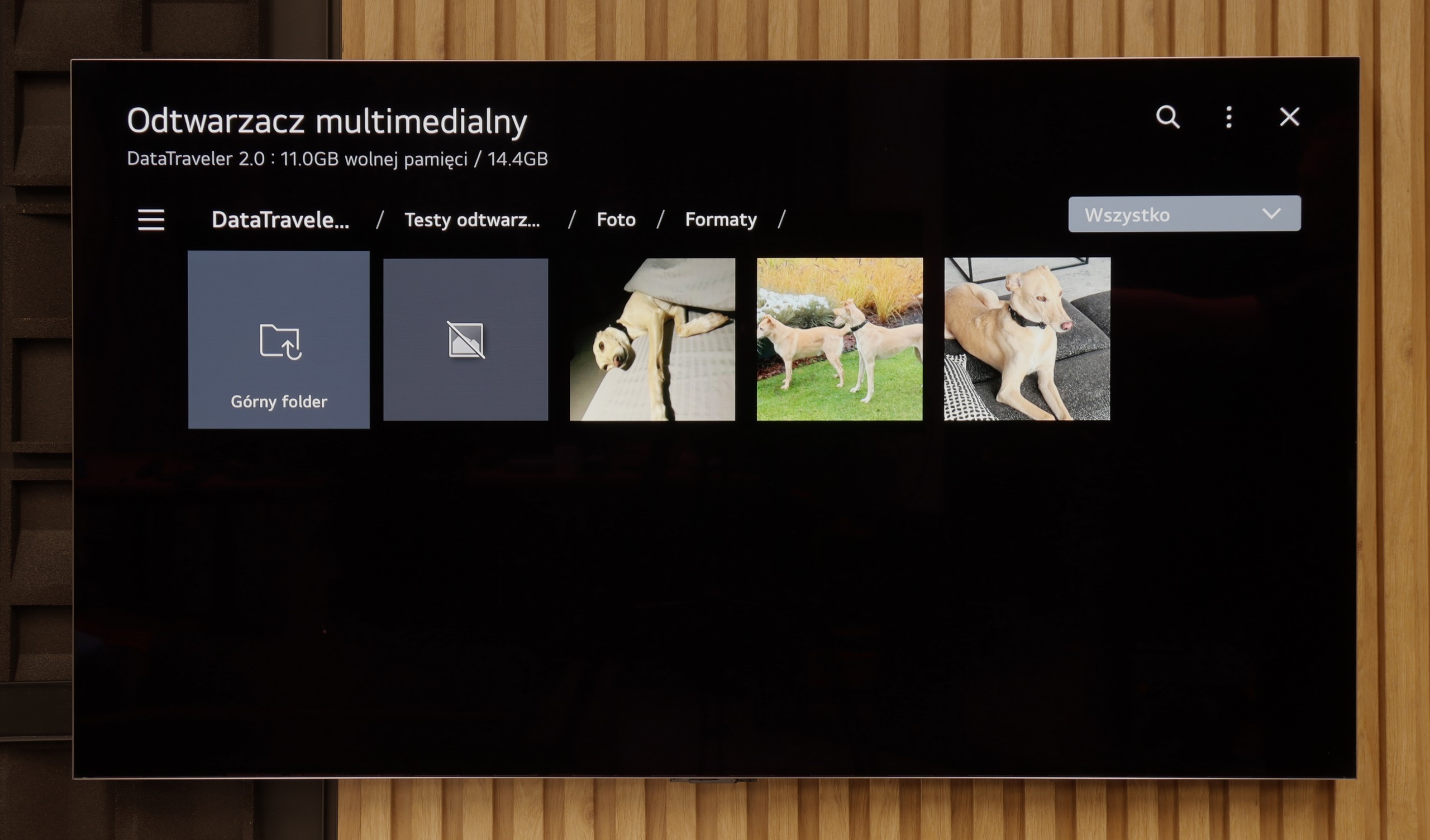
The default file player on LG C4 handles all photo resolutions exceptionally well. It successfully plays videos recorded in practically all the most popular formats, including Dolby Vision. The only codec that the C4 won't play is H.266 VVC, although this is currently rather uncommon. It's a pity that subtitles in .txt format are not supported. Attention should be paid to the supported photo formats, of which there are only three: JPEG, PNG, and, importantly for Apple phone users - HEIC. However, the tested television cannot be faulted for a lack of variety in audio files, which can be played without a compatibility warning.
The built-in media player in the LG G5 is really quite good. It supports virtually everything you can expect from a modern television – most popular formats work without any issues, and the app's performance is fast. Our only disappointment was the lack of support for very high-bitrate HEVC files at 85 Mbit/s – similar to the C5 and B5 models. Interestingly, the same file played flawlessly on last year's LG OLEDs, so it's hard to say what has caused this change. Nevertheless, in everyday use, the G5 will handle the vast majority of materials, and there will be no need to connect any external devices for media playback.
Apps
9.1/10
9.1/10














































Sound
7.5/10
8.7/10
- Maximum volume--
- Dolby Digital Plus 7.1
- Dolby True HD 7.1
- Dolby Atmos in Dolby Digital Plus (JOC)
- Dolby Atmos in Dolby True HD
- DTS:X in DTS-HD MA
- DTS-HD Master Audio
The audio system implemented in LG C4 is very well tuned, allowing us to experience strong bass as well as balanced mid and high tones. We can confidently say that in its price range, it's one of the better sounding televisions. However, we believe that those deciding to purchase the C4 will already have a dedicated audio set. The presence of DTS-HD Master Audio and Dolby Atmos codecs will also be significant.
The sound on the LG G5, considering its slim design, is truly phenomenal. When listening to music, you can sense a light, pleasant bass, and in films, the dialogue is clear and easy to hear – it doesn’t get lost even in dynamic scenes. Unfortunately, a bit of a disappointment is the lack of support for the DTS format, which LG used in its older models. It's a shame, as many home theatre enthusiasts might see this as a step backwards.


